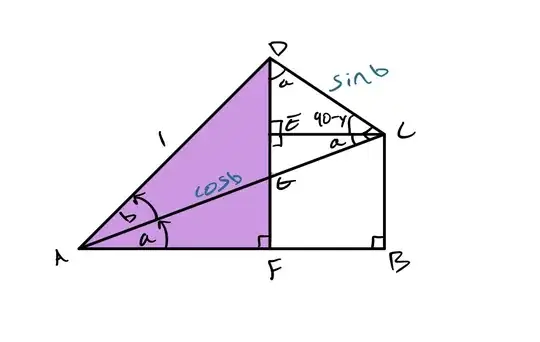I was able to derive $\sin(a+b)$ using a geometric construction of two terminal rays where the long 1 has a hypotenuse of 1. The right triangle with hypotenuse 1 formed by angle $b$ is the triangle $\triangle ADC$, the other right triangle formed by angle $a$ is $\triangle ACB$.
 I saw that $\overline{CB}=\sin a \cos b$ and $\overline{DE}=\cos a \sin b$. Likewise I notice that $\cos(a+b)=\overline{AF}$. But I'm having no success using what I know about the double angle of sine to derive the formula for the double angle of cosine. I tried using similar triangles and the farthest that got me is that $\overline{AB}=\sin a \cos^2 b$
I saw that $\overline{CB}=\sin a \cos b$ and $\overline{DE}=\cos a \sin b$. Likewise I notice that $\cos(a+b)=\overline{AF}$. But I'm having no success using what I know about the double angle of sine to derive the formula for the double angle of cosine. I tried using similar triangles and the farthest that got me is that $\overline{AB}=\sin a \cos^2 b$
Asked
Active
Viewed 59 times
1
Lex_i
- 2,072
- 10
- 26
-
see https://www.math-only-math.com/proof-of-compound-angle-formula-cos-alpha-plus-beta.html#:~:text=Proof%3A%20From%20triangle%20ACE%20we,%3D%20alternate%20%E2%88%A0COX%20%3D%20%CE%B1.&text=3.,of%20(A%20%2 – Albus Dumbledore Sep 27 '20 at 04:10
-
2See my answer here. – Blue Sep 27 '20 at 04:49